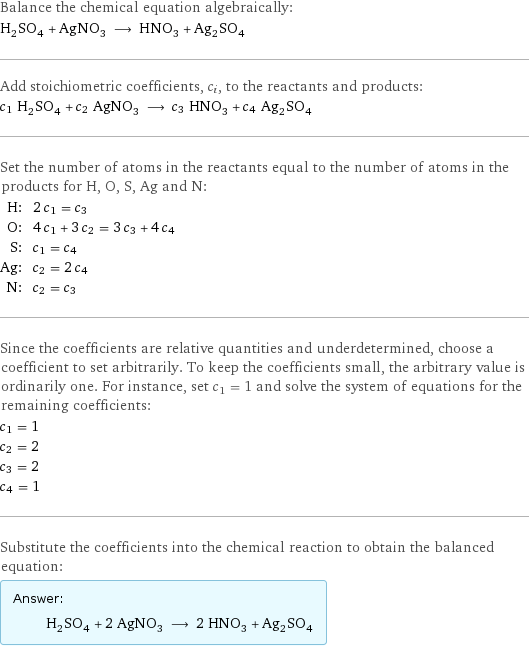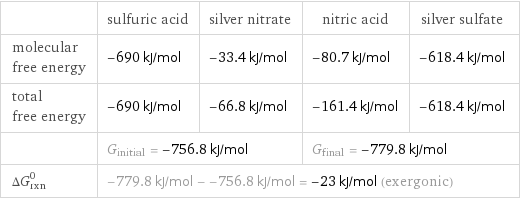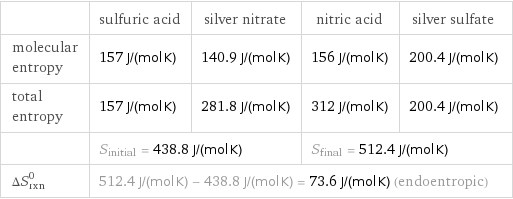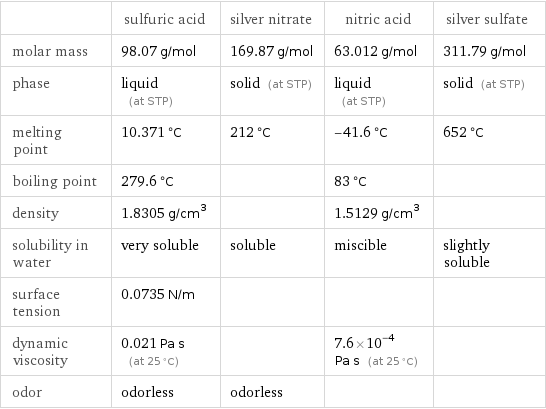Input interpretation

H_2SO_4 sulfuric acid + AgNO_3 silver nitrate ⟶ HNO_3 nitric acid + Ag_2SO_4 silver sulfate
Balanced equation

Balance the chemical equation algebraically: H_2SO_4 + AgNO_3 ⟶ HNO_3 + Ag_2SO_4 Add stoichiometric coefficients, c_i, to the reactants and products: c_1 H_2SO_4 + c_2 AgNO_3 ⟶ c_3 HNO_3 + c_4 Ag_2SO_4 Set the number of atoms in the reactants equal to the number of atoms in the products for H, O, S, Ag and N: H: | 2 c_1 = c_3 O: | 4 c_1 + 3 c_2 = 3 c_3 + 4 c_4 S: | c_1 = c_4 Ag: | c_2 = 2 c_4 N: | c_2 = c_3 Since the coefficients are relative quantities and underdetermined, choose a coefficient to set arbitrarily. To keep the coefficients small, the arbitrary value is ordinarily one. For instance, set c_1 = 1 and solve the system of equations for the remaining coefficients: c_1 = 1 c_2 = 2 c_3 = 2 c_4 = 1 Substitute the coefficients into the chemical reaction to obtain the balanced equation: Answer: | | H_2SO_4 + 2 AgNO_3 ⟶ 2 HNO_3 + Ag_2SO_4
Structures

+ ⟶ +
Names

sulfuric acid + silver nitrate ⟶ nitric acid + silver sulfate
Reaction thermodynamics
Gibbs free energy

| sulfuric acid | silver nitrate | nitric acid | silver sulfate molecular free energy | -690 kJ/mol | -33.4 kJ/mol | -80.7 kJ/mol | -618.4 kJ/mol total free energy | -690 kJ/mol | -66.8 kJ/mol | -161.4 kJ/mol | -618.4 kJ/mol | G_initial = -756.8 kJ/mol | | G_final = -779.8 kJ/mol | ΔG_rxn^0 | -779.8 kJ/mol - -756.8 kJ/mol = -23 kJ/mol (exergonic) | | |
Entropy

| sulfuric acid | silver nitrate | nitric acid | silver sulfate molecular entropy | 157 J/(mol K) | 140.9 J/(mol K) | 156 J/(mol K) | 200.4 J/(mol K) total entropy | 157 J/(mol K) | 281.8 J/(mol K) | 312 J/(mol K) | 200.4 J/(mol K) | S_initial = 438.8 J/(mol K) | | S_final = 512.4 J/(mol K) | ΔS_rxn^0 | 512.4 J/(mol K) - 438.8 J/(mol K) = 73.6 J/(mol K) (endoentropic) | | |
Equilibrium constant
![Construct the equilibrium constant, K, expression for: H_2SO_4 + AgNO_3 ⟶ HNO_3 + Ag_2SO_4 Plan: • Balance the chemical equation. • Determine the stoichiometric numbers. • Assemble the activity expression for each chemical species. • Use the activity expressions to build the equilibrium constant expression. Write the balanced chemical equation: H_2SO_4 + 2 AgNO_3 ⟶ 2 HNO_3 + Ag_2SO_4 Assign stoichiometric numbers, ν_i, using the stoichiometric coefficients, c_i, from the balanced chemical equation in the following manner: ν_i = -c_i for reactants and ν_i = c_i for products: chemical species | c_i | ν_i H_2SO_4 | 1 | -1 AgNO_3 | 2 | -2 HNO_3 | 2 | 2 Ag_2SO_4 | 1 | 1 Assemble the activity expressions accounting for the state of matter and ν_i: chemical species | c_i | ν_i | activity expression H_2SO_4 | 1 | -1 | ([H2SO4])^(-1) AgNO_3 | 2 | -2 | ([AgNO3])^(-2) HNO_3 | 2 | 2 | ([HNO3])^2 Ag_2SO_4 | 1 | 1 | [Ag2SO4] The equilibrium constant symbol in the concentration basis is: K_c Mulitply the activity expressions to arrive at the K_c expression: Answer: | | K_c = ([H2SO4])^(-1) ([AgNO3])^(-2) ([HNO3])^2 [Ag2SO4] = (([HNO3])^2 [Ag2SO4])/([H2SO4] ([AgNO3])^2)](../image_source/74ae7a6b7115d544eb05f74961ab2cc4.png)
Construct the equilibrium constant, K, expression for: H_2SO_4 + AgNO_3 ⟶ HNO_3 + Ag_2SO_4 Plan: • Balance the chemical equation. • Determine the stoichiometric numbers. • Assemble the activity expression for each chemical species. • Use the activity expressions to build the equilibrium constant expression. Write the balanced chemical equation: H_2SO_4 + 2 AgNO_3 ⟶ 2 HNO_3 + Ag_2SO_4 Assign stoichiometric numbers, ν_i, using the stoichiometric coefficients, c_i, from the balanced chemical equation in the following manner: ν_i = -c_i for reactants and ν_i = c_i for products: chemical species | c_i | ν_i H_2SO_4 | 1 | -1 AgNO_3 | 2 | -2 HNO_3 | 2 | 2 Ag_2SO_4 | 1 | 1 Assemble the activity expressions accounting for the state of matter and ν_i: chemical species | c_i | ν_i | activity expression H_2SO_4 | 1 | -1 | ([H2SO4])^(-1) AgNO_3 | 2 | -2 | ([AgNO3])^(-2) HNO_3 | 2 | 2 | ([HNO3])^2 Ag_2SO_4 | 1 | 1 | [Ag2SO4] The equilibrium constant symbol in the concentration basis is: K_c Mulitply the activity expressions to arrive at the K_c expression: Answer: | | K_c = ([H2SO4])^(-1) ([AgNO3])^(-2) ([HNO3])^2 [Ag2SO4] = (([HNO3])^2 [Ag2SO4])/([H2SO4] ([AgNO3])^2)
Rate of reaction
![Construct the rate of reaction expression for: H_2SO_4 + AgNO_3 ⟶ HNO_3 + Ag_2SO_4 Plan: • Balance the chemical equation. • Determine the stoichiometric numbers. • Assemble the rate term for each chemical species. • Write the rate of reaction expression. Write the balanced chemical equation: H_2SO_4 + 2 AgNO_3 ⟶ 2 HNO_3 + Ag_2SO_4 Assign stoichiometric numbers, ν_i, using the stoichiometric coefficients, c_i, from the balanced chemical equation in the following manner: ν_i = -c_i for reactants and ν_i = c_i for products: chemical species | c_i | ν_i H_2SO_4 | 1 | -1 AgNO_3 | 2 | -2 HNO_3 | 2 | 2 Ag_2SO_4 | 1 | 1 The rate term for each chemical species, B_i, is 1/ν_i(Δ[B_i])/(Δt) where [B_i] is the amount concentration and t is time: chemical species | c_i | ν_i | rate term H_2SO_4 | 1 | -1 | -(Δ[H2SO4])/(Δt) AgNO_3 | 2 | -2 | -1/2 (Δ[AgNO3])/(Δt) HNO_3 | 2 | 2 | 1/2 (Δ[HNO3])/(Δt) Ag_2SO_4 | 1 | 1 | (Δ[Ag2SO4])/(Δt) (for infinitesimal rate of change, replace Δ with d) Set the rate terms equal to each other to arrive at the rate expression: Answer: | | rate = -(Δ[H2SO4])/(Δt) = -1/2 (Δ[AgNO3])/(Δt) = 1/2 (Δ[HNO3])/(Δt) = (Δ[Ag2SO4])/(Δt) (assuming constant volume and no accumulation of intermediates or side products)](../image_source/0584a8e0b12355ccd79206af3662d8d7.png)
Construct the rate of reaction expression for: H_2SO_4 + AgNO_3 ⟶ HNO_3 + Ag_2SO_4 Plan: • Balance the chemical equation. • Determine the stoichiometric numbers. • Assemble the rate term for each chemical species. • Write the rate of reaction expression. Write the balanced chemical equation: H_2SO_4 + 2 AgNO_3 ⟶ 2 HNO_3 + Ag_2SO_4 Assign stoichiometric numbers, ν_i, using the stoichiometric coefficients, c_i, from the balanced chemical equation in the following manner: ν_i = -c_i for reactants and ν_i = c_i for products: chemical species | c_i | ν_i H_2SO_4 | 1 | -1 AgNO_3 | 2 | -2 HNO_3 | 2 | 2 Ag_2SO_4 | 1 | 1 The rate term for each chemical species, B_i, is 1/ν_i(Δ[B_i])/(Δt) where [B_i] is the amount concentration and t is time: chemical species | c_i | ν_i | rate term H_2SO_4 | 1 | -1 | -(Δ[H2SO4])/(Δt) AgNO_3 | 2 | -2 | -1/2 (Δ[AgNO3])/(Δt) HNO_3 | 2 | 2 | 1/2 (Δ[HNO3])/(Δt) Ag_2SO_4 | 1 | 1 | (Δ[Ag2SO4])/(Δt) (for infinitesimal rate of change, replace Δ with d) Set the rate terms equal to each other to arrive at the rate expression: Answer: | | rate = -(Δ[H2SO4])/(Δt) = -1/2 (Δ[AgNO3])/(Δt) = 1/2 (Δ[HNO3])/(Δt) = (Δ[Ag2SO4])/(Δt) (assuming constant volume and no accumulation of intermediates or side products)
Chemical names and formulas

| sulfuric acid | silver nitrate | nitric acid | silver sulfate formula | H_2SO_4 | AgNO_3 | HNO_3 | Ag_2SO_4 Hill formula | H_2O_4S | AgNO_3 | HNO_3 | Ag_2O_4S name | sulfuric acid | silver nitrate | nitric acid | silver sulfate IUPAC name | sulfuric acid | silver nitrate | nitric acid | disilver sulfate
Substance properties

| sulfuric acid | silver nitrate | nitric acid | silver sulfate molar mass | 98.07 g/mol | 169.87 g/mol | 63.012 g/mol | 311.79 g/mol phase | liquid (at STP) | solid (at STP) | liquid (at STP) | solid (at STP) melting point | 10.371 °C | 212 °C | -41.6 °C | 652 °C boiling point | 279.6 °C | | 83 °C | density | 1.8305 g/cm^3 | | 1.5129 g/cm^3 | solubility in water | very soluble | soluble | miscible | slightly soluble surface tension | 0.0735 N/m | | | dynamic viscosity | 0.021 Pa s (at 25 °C) | | 7.6×10^-4 Pa s (at 25 °C) | odor | odorless | odorless | |
Units
